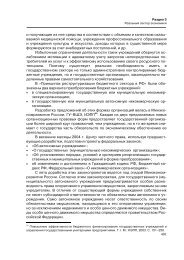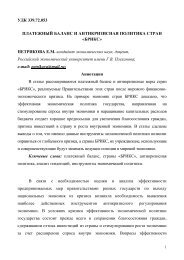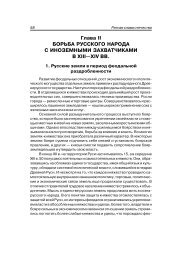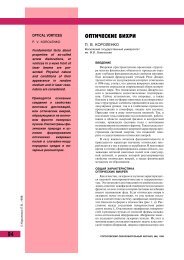Ensuring Strategic Stability in the Past and Present:
Ensuring Strategic Stability in the Past and Present:
Ensuring Strategic Stability in the Past and Present:
You also want an ePaper? Increase the reach of your titles
YUMPU automatically turns print PDFs into web optimized ePapers that Google loves.
(MWS), space surveillance systems (SSS), SNF comm<strong>and</strong> <strong>and</strong> control systems <strong>and</strong> anti-missiledefense systems, <strong>and</strong> for simulation of relevant projects related to <strong>the</strong> development of new typesof nuclear munitions, which is especially important when actual full-scale test<strong>in</strong>g is lack<strong>in</strong>g. Newtypes of nuclear munitions (or modernization of <strong>the</strong> exist<strong>in</strong>g ones) are required for penetrationof warheads through <strong>the</strong> o<strong>the</strong>r side’s missile defense (MD) systems, which <strong>in</strong> <strong>the</strong> modern contextbecomes a very topical problem for Russia’s forces <strong>and</strong> means of nuclear deterrence.In <strong>the</strong> Cold War period, <strong>the</strong> sides recurrently made (<strong>and</strong> not always successfully) such strategicgestures as <strong>in</strong>creases <strong>in</strong> <strong>the</strong> combat read<strong>in</strong>ess of <strong>the</strong>ir military forces (<strong>in</strong>clud<strong>in</strong>g <strong>the</strong>ir nuclear components),<strong>the</strong> projection of strategic <strong>and</strong> front-l<strong>in</strong>e (tactical) aviation assets that were capable ofcarry<strong>in</strong>g nuclear weapons, <strong>and</strong> <strong>the</strong> displacement of surface warship units (<strong>in</strong>clud<strong>in</strong>g <strong>the</strong> ones withnuclear munitions).The consequences of such gestures were not always sized up by one side or <strong>the</strong> o<strong>the</strong>r, but <strong>the</strong>ywere based on <strong>the</strong> <strong>in</strong>tention to atta<strong>in</strong> a certa<strong>in</strong> political result—ei<strong>the</strong>r to prevent <strong>the</strong> crisis or toput an end to it on mutually acceptable conditions. (In a number of <strong>in</strong>stances, one side or <strong>the</strong>o<strong>the</strong>r made serious <strong>and</strong> quite dangerous mistakes, which must never be forgotten ei<strong>the</strong>r by <strong>the</strong>state leadership or by <strong>the</strong> military comm<strong>and</strong>.) 56 Needless to say, <strong>in</strong> order to provide for consistentactivities aimed at <strong>the</strong> prevention of escalatory dom<strong>in</strong>ation, it is necessary to have state-of-<strong>the</strong>artgeneral-purpose forces as well as relevant conventional arms. Without that, any political <strong>and</strong>military confrontation between Russia <strong>and</strong> a serious opponent may jump over to <strong>the</strong> nuclear levelof <strong>the</strong> escalation ladder.One should not lose sight of <strong>the</strong> fact that quite often, such actions were (<strong>and</strong> are) taken not just tocatch <strong>the</strong> opponent’s fancy (<strong>and</strong> thus <strong>in</strong>fluence its behavior), but for domestic consumption too.The latter aspect is def<strong>in</strong>itely underestimated by many political scientists, <strong>and</strong> all <strong>the</strong> more so bymilitary experts, particularly <strong>in</strong> <strong>the</strong> context of crisis management tasks.32<strong>Ensur<strong>in</strong>g</strong> <strong>Strategic</strong> <strong>Stability</strong> <strong>in</strong> <strong>the</strong> <strong>Past</strong> <strong>and</strong> <strong>Present</strong>: Theoretical <strong>and</strong> Applied Questions
















